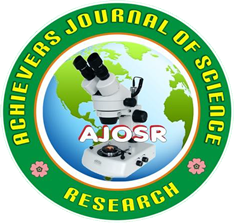Biosurfactant Production by Some Microbes Isolated from Some Departmental General Offices at the University of Ilorin
Keywords:
Air Microflora, Bacteria, Biosurfactant, Fungi, IlorinAbstract
Air contains large number of microorganisms including bacteria and fungi and their estimation is important as an index of
cleanliness for any particular environment. Ability of a microorganism to produce biosurfactant is an indicator of its
hydrocarbon degradation capability. The air microflora of five different offices at the faculty of Life Sciences in the University
of Ilorin was examined by exposing plates on nutrient agar and potato dextrose agar at different locations in the offices. The
bacterial load obtained ranged from 20,445 to 24,849 cfu/m3 whiles the fungal load ranged from 5,269 to 10,144 cfu/m3
. A
total of 6 bacterial and 10 fungal species were isolated at varying frequency of distribution. The bacteria isolated were
Pseudomonas aeruginosa, Micrococcus varians, Staphylococcus epidermidis, Bacillus circulans, Staphylococcus aureus and
Bacillus subtilis. The most predominant bacterial isolate was Staphylococcus aureus while the least was, Bacillus circulans.
The fungi isolated were Aspergillus niger, Penicillum chrysogenum, Cladosporium herbarum, Aspergillus nidulans, Mucor
mucedo, Geotrichum candidum, Fusarium oxysporum and Rhizopus stolonifer. The predominant fungal isolate was
Aspergillus niger while Fusarium oxysporum was the least predominant. The highest emulsification index was observed in
Pseudomonas aureginosa with an E24% of 50% using crude oil as its carbon source. Pseudomonas aeruginosa and Bacillus
Bacillus subtilis showed promise oof biosurfactant production and hence petroleum biodegradation. This will be explored
further in our next study. Most of the microorganisms are opportunistic pathogens especially in immunocompromised
individuals. Therefore, proper air sanitation is advised in offices to prevent infection.





